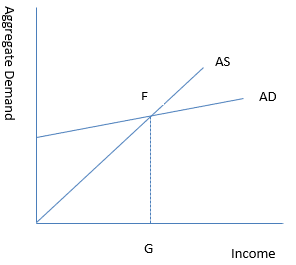What is ‘effective demand’? How will you derive the autonomous expenditure multiplier when price of final goods and the rate of interest are given?
When aggregate demand is at the point of equilibrium it is called effective demand because at this point it becomes effective in determining the national income. Effective demand is that level of demand which is fully made by corresponding supply and there is no tendency of expansion and contraction.
According to Keynesian theory, in short run the equilibrium level of income and employment is determined by the level of effective demand because aggregate supply or national income is assumed to be given and constant at that level.

E is the equilibrium point where the aggregate supply (AS) curve and aggregate demand (AD) curve meet, EG is the effective demand and output level is determined by AD
Autonomous expenditure multiplier
Y = AD (at equilibrium)
AD = A + cY
Y = A + cY
Y - cY = A
Y (1 - c) = A
Y = A / (1 – c)
Where,
A = Autonomous expenditure
c = MPC
Y = level of income
A / (1 – c) = autonomous expenditure multiplier
So, the autonomous expenditure multiplier is dependent on the income and MPC.